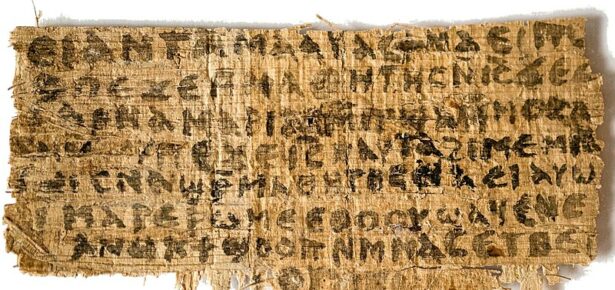
On 18 September 2012, Rome played host to the quadrennial conference of the International Congress of Coptic Studies. On the evening of that day, the Harvard-based feminist historian Karen King (1054-) delivered a paper bearing the seemingly harmless title ‘A New Coptic Fragment.’
King announced the discovery of a fragment of papyrus that came, she believed, from the fourth century. It was only about the size of a credit card. But it would bring into question the long Christian tradition that Jesus was unmarried.
This fragment, she suggested, was part of a larger lost gospel which she dubbed ‘just simply for reference purposes – “The Gospel of Jesus’s Wife”.’
The fragment read as follows:
“not [to] me. My mother gave me life …”
”The disciples said to Jesus, “…
… deny. Mary is (not?) worthy of it…
…” Jesus said to them, “My wife…
… she is able to be my disciple…
… Let wicked people swell up …
… As for me, I am with her in order to…
… an image…
According to King, the woman referred to as the wife of Jesus was Mary Magdalene.
Not surprisingly, King made world-wide headlines across the globe. This seemed, after all, to verify Dan Brown’s fanciful claim in The Da Vinci Code that Jesus and Mary were husband and wife. This was really the ‘Holy Grail’ (apologies to Dan Brown here) of early Christian studies. Feminist historians and theologians committed to the enhancement of the role of women in the church rejoiced – a little prematurely, as we will see.
Was the papyrus fragment authentic or a modern forgery? In the end, the scientific evidence drifted towards its being a fake. Despite its being written on ancient papyrus with ink made from an ancient recipe, the author was not the greatest at the Coptic language.
But King stuck to her guns. On its being a modern fake, she wrote, ‘In my judgment, such a combination of bumbling and sophistication seems extremely unlikely. Yet, ‘a combination of bumbling and sophistication’ was exactly what it was.
For, as it turned out, ‘The Gospel of Jesus’s Wife’ was the product of a frustrated German Egyptologist with limited Coptic skills by the name of Walter Fritz living then in Florida.
He had obtained a fragment of centuries-old papyrus and had made ink from ancient recipes. He had written a text upon it in passable Coptic, had created persuasive background documents, and had offered it to Karen King in July 2010. He gave it to her in December 2011 and, nine months later, she proclaimed her ‘bombshell’ discovery at the Coptic conference in Rome.
Why did Fritz do it? Well, simply put, it was his payback for the failure of the academic world of Coptologists to recognise his brilliance. But it was more than that. For interestingly, Walter Fritz had, in effect, turned Dan Brown’s fantasy in The Da Vinci Code into reality. The Da Vinci Code’s ‘academic as hero’ Harvard Professor Robert Langdon became the real life Harvard historian Karen King. And Brown’s fanciful reading of Da Vinci’s ‘Last Supper’ came to life in an ancient papyrus designed to provide material proof of the marriage of Jesus and Mary.
The overwhelming modern scholarly consensus is that there is no decisive evidence of an early Christian tradition that Jesus and Mary Magdalene were married. Karen King eventually admitted that she had been duped. Her experience will probably ensure that, in the immediate future at least, this is a rabbit hole down which no modern scholars will want to go.
Latest Comments
Have your say!